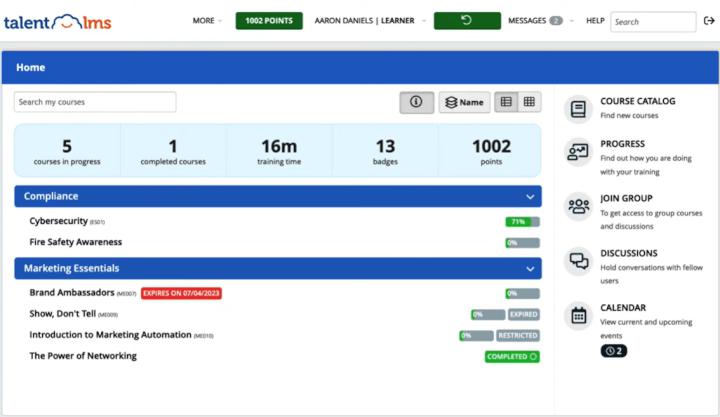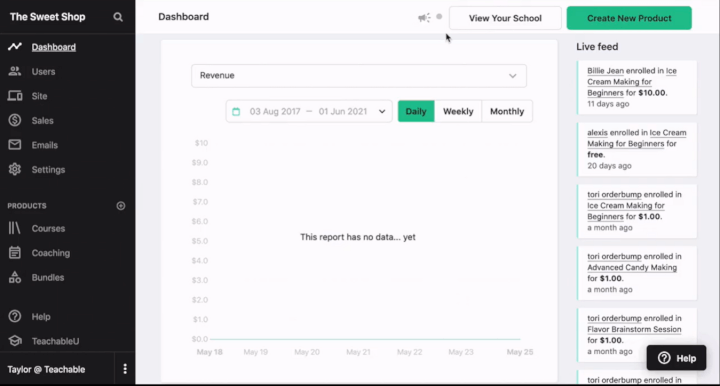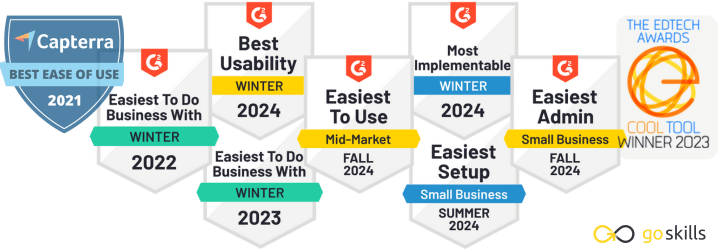An easy-to-use LMS platform can validate corporate training programs by driving measurable returns on investment. At a minimum, this requires an intuitive interface, engaging course experiences, and clear analytics to track progress effectively.
Organizations with more complex needs may gravitate toward feature-rich LMS platforms, assuming they will better meet their requirements. While customization is often a priority for larger organizations, it typically comes with added complexity—something these organizations are equipped to manage with their robust technical infrastructures.
To illustrate, consider this ease-of-use comparison between a simple LMS like GoSkills and a more complex one like SAP Litmos:
| Feature | GoSkills | SAP Litmos |
|---|---|---|
|
Ease of setup |
Always-on, cloud-based SaaS—beyond user signups, no additional configuration is required. |
Also cloud-based, but often requires complex integration with third-party tools like Salesforce, Zendesk, or HRIS systems. |
|
Course building ease |
Pre-built templates and an AI-powered course creator make course-building a breeze. |
Embedding custom multimedia content, such as interactive videos, requires technical HTML5 knowledge. |
|
User engagement |
Bite-sized lessons, built-in gamification features help to make learning a pleasure. |
Supports gamification and multimedia but needs more setup to achieve similar engagement levels. |
|
User analytics |
Straightforward reports available at a click charting time spent learning, learner progress, and upskilling. |
Detailed reporting with advanced analytics, but requires configuration and training to utilize. |
|
Integration complexity |
Simple integrations with minimal technical knowledge needed. |
Extensive integration options (e.g., Salesforce, Zendesk) but require IT expertise to implement. |
|
Best suited for |
Small, medium, and enterprise-sized businesses. |
Enterprise training for compliance and professional development. |
This comparison underscores the critical role of infrastructure in selecting and deploying an LMS. While GoSkills meets many organizational needs with minimal setup, more complex platforms like SAP Litmos demand enterprise-level resources and expertise for effective utilization.
Similarly, platforms like Moodle, while appearing simple at first, can become challenging as requirements expand. Enhancing functionality through plugins and themes often demands technical proficiency in PHP and MySQL, making it difficult for non-technical course creators to manage workflows for quizzes, grading, and course management seamlessly.
Skip to the chase: Top 6 easy-to-use LMS platforms
Choosing the right learning management system (LMS) is critical for ensuring a smooth learning experience that meets both organizational and learner needs. While complex systems may appeal to organizations with technical infrastructure, for many, simplicity and usability are key to driving engagement and achieving a meaningful return on investment (ROI).
With that in mind, here are the top LMS platforms recognized for their ease of use. Whether for corporate training or educational purposes, these user-friendly platforms streamline workflows, enhance engagement, and save time for administrators, instructors, and learners alike.
| 1. | GoSkills LMS | 2. | Absorb LMS |
| 3. | Canvas LMS | 4. | Google Classroom |
| 5. | TalentLMS | 6. | Teachable |
Before exploring the ease of use for any recommended LMS, consider these key assessment points:
What makes a learning management system easy to use?
The following key factors contribute to an LMS being considered user-friendly:
1. Intuitive interface
A simple, clean design that helps users and administrators navigate easily.
For learners:
- A simple, clean design ensures users can easily navigate the platform without confusion.
- Clear menus, icons, and instructions help learners focus on absorbing course material rather than struggling with the system.
- Easier navigation leads to faster adoption, higher course completion rates, and better training outcomes.
For administrators:
- Reduces time spent troubleshooting and managing the platform.
- Simplifies tasks such as course creation, progress tracking, and updates, even for non-technical users.
- Boosts productivity by allowing administrators to focus on content and outcomes rather than technical challenges.
Overall benefit: A well-designed interface minimizes the learning curve for all users. This ensures that it supports, rather than hinders, the training process.
2. Quick setup
Quick setup is vital for organizations aiming to deliver training without delays. Here’s why:
Minimal technical requirements:
- Ensures businesses can implement the system quickly, reducing downtime.
- Allows learners to start courses immediately without waiting for complex configurations.
For small businesses or limited IT resources:
- Avoids the need for extensive technical support or lengthy onboarding periods.
- Reduces barriers for teams with minimal infrastructure or technical expertise.
Reduced administrative burden:
- Frees managers and instructors to focus on creating and delivering training content rather than handling technical issues.
- Streamlines the process, letting organizations dedicate time to improving the learning experience.
Faster return on investment (ROI):
- Quick setup enables organizations to start meeting their learning and development goals almost immediately.
- Minimizes setup delays, helping businesses see results sooner.

3. Strong support
Responsive customer service is a critical factor when selecting an LMS. Here’s why:
Enhances ease of use:
- Accessible support ensures that help is always available when needed.
- Builds confidence among users, enabling them to fully leverage the LMS.
Keeps training programs running smoothly:
- Addresses technical issues, feature-related questions, or setup guidance promptly.
- Reduces frustration and downtime for administrators and learners alike.
Maximizes LMS value:
- Support teams can assist with customization, integrations, and implementing best practices.
- Proactive and knowledgeable support helps organizations tailor the LMS to their specific needs and goals.
Critical for new users or personalized needs:
- Essential for organizations new to using an LMS or those requiring personalized configurations.
- Ensures a smoother onboarding process and better alignment with organizational requirements.
4. Low learning curve
Learners can get started with minimal instruction.
Quick adoption
- A low learning curve ensures both administrators and learners can quickly get comfortable with the platform.
- Minimizes the time needed for training or onboarding.
Intuitive navigation
-
With a system that's is easy to navigate, users spend less time figuring out how it works and more time on learning and course management.
Improved efficiency
- Reduces frustration and accelerates adoption.
- Helps organizations deliver training more effectively.
Better user experience
- Seamless onboarding process for learners and administrators, resulting in a more positive overall experience.
5. Effortless course creation
Drag-and-drop features and pre-built templates that make content creation simple
User-friendly tools
- Drag-and-drop features simplify content creation.
- Pre-built templates allow instructors to design courses quickly and efficiently.
No tech expertise required
- Instructors can build and manage content without needing advanced technical skills.
- Focus stays on crafting engaging material, not navigating complex systems.
Flexible and adaptable
- Courses can be easily updated or tweaked to ensure training remains fresh and relevant.
- Enables organizations to respond quickly to changing needs.
A game-changer for agility
- Simplified course creation allows learning programs to stay agile and responsive.
- Ideal for organizations that value efficiency and adaptability in training.
A clunky learning management system is a headache for administrators, frustrates learners, and doesn't offer the training ROI you deserve. A user-friendly LMS helps you hit your targets faster.
Best simple LMS platforms for 2025
Choosing the right LMS can significantly impact your organization's training outcomes. The following platforms have been recognized for their simplicity, ease of setup, and user-friendly features, making them ideal for businesses seeking effective yet straightforward solutions.
1. GoSkills LMS
User-friendly interface: ⭐⭐⭐⭐⭐
Course building ease: ⭐⭐⭐⭐⭐
Best suited for: Small, medium, and enterprise-sized businesses
GoSkills LMS is an intuitive, easy-to-use learning management system, which is especially valuable for small to mid-sized businesses. The platform received recognition for “Best Usability” and "Most Implementable" in Winter 2024 by users of the independent software marketplace G2, making it an excellent choice for organizations that prioritize ease of use.
Key strengths:
- Quick setup – GoSkills earned G2’s award for “Easiest Setup” for Small Business in Spring and Summer 2024, meaning that businesses can get started quickly without complex configurations.
- Reliable support – With an onboarding wizard, a helpful support team, an online knowledge base, and pre-built courses, most organizations can complete implementation and have their teams ready to go in about one hour.
- Plug and play features – G2 also awarded GoSkills the "Easiest to Use" badge for Winter 2024, confirming its ease for both learners and administrators. The course builder features course templates, an AI content authoring assistant, easy addition of multimedia elements, and more. The course recommender feature suggests courses based on the learner's interests and history.
- Easiest administration – With an admin-friendly dashboard and built-in reports, GoSkills helps organizations manage learners, assign courses, and track progress effortlessly.
- User-friendly interface – Learners can navigate their courses, complete quizzes, and track progress using a clean, modern user design. GoSkills has been featured as a Leader among learning experience platforms by G2.

GoSkills is an easy-to-use LMS geared especially towards corporate training. To determine whether it's right for your team, check out these features and compare them with your organization's requirements.
Experience the difference
Start transforming the way your organization learns — no credit card required. Get started in minutes!
Create your free account now2. Absorb LMS
Absorb LMS provides a clean, intuitive interface and a strong set of features for both corporate training and higher education.

Key strengths:
- User-friendly interface – Absorb’s sleek design allows learners to easily navigate courses.
- Comprehensive support – The platform offers detailed customer support and resources to assist with implementation.
- Course content library – Absorb LMS provides a wide range of pre-built course content, allowing organizations to quickly get started.
Absorb is best suited for mid-sized businesses and organizations looking for an LMS that offers strong support alongside an easy user experience.
3. Canvas LMS
Canvas is a popular LMS used in both educational and corporate settings. It’s known for its modern design and mobile accessibility, offering a relatively low learning curve for both learners and admins.

Key strengths:
- Mobile-friendly – Canvas has one of the best mobile experiences, allowing learners to easily access courses on any device.
- Straightforward course creation – Instructors can create and update courses with a simple drag-and-drop interface.
- Collaborative features – Canvas allows for discussion boards and peer-to-peer collaboration, enhancing the learning experience.
Canvas is a good option for educational institutions and businesses that want a modern, easy-to-use platform, but it may require more support for larger organizations.
4. Google Classroom
Google Classroom is a cloud-based learning management system (LMS) designed to simplify the creation, distribution, and management of educational content. Primarily aimed at schools, educators, and small teams, it integrates seamlessly with Google Workspace tools like Google Docs, Sheets, Slides, and Drive.

Key strengths:
- Seamless integration – Works effortlessly with Google Workspace tools, allowing users to collaborate, submit assignments, and share resources directly through the platform.
- Minimal learning curve – Its clean, straightforward interface ensures that educators and students can start using it immediately without extensive training.
- Free for education – As part of Google Workspace for Education, it’s free for schools, making it an excellent choice for budget-conscious institutions.
While it’s geared more toward educational settings, Google Classroom can be a limitation for organizations needing advanced features like detailed analytics or large-scale corporate training.
5. TalentLMS
TalentLMS is another cloud-based platform known for its simple setup and easy-to-use interface. It's popular with small and medium-sized businesses looking for a fast, flexible solution.

Key strengths:
- Customizable and mobile-friendly – TalentLMS allows for portal customization and can be accessed on any device, making it easy for users on the go.
- Drag-and-drop course creation – TalentLMS offers course-building tools that allow trainers to upload materials and create content with minimal effort.
While TalentLMS is user-friendly for smaller businesses, some users report needing more assistance when managing larger training programs.
6. Teachable
Teachable is a highly accessible LMS that specializes in helping individuals and small businesses create and sell online courses. It offers an easy-to-navigate interface for both course creators and learners.

Key strengths:
- Easy course creation – Teachable offers an intuitive course builder that allows even non-technical users to create professional courses.
- Ecommerce integration – It includes built-in tools to help course creators monetize their content.
- Simple user interface – Learners can easily browse, enroll in, and complete courses with little to no instruction.
While Teachable is great for small businesses and entrepreneurs, larger organizations may find its feature set limiting compared to other platforms like GoSkills or Absorb LMS.
Balance simplicity and scalability to find the perfect LMS
The success of an LMS hinges on how well it aligns with your team’s technical capabilities and long-term goals. While enterprise-class businesses with robust IT teams can manage complex, customizable platforms, smaller organizations often benefit more from simple, user-friendly LMS solutions. These platforms minimize administrative burden and allow teams to focus on delivering effective training without getting bogged down by technical complexities.

Exercise: Assessing your team’s LMS needs
Use this exercise to assess your training requirements and ensure your chosen LMS aligns with your current needs and future goals.
1. Define your training goals
- What are the primary objectives of your training program?
- Examples: Staff onboarding, skill development, compliance training, or upskilling.
- Are these objectives short-term or part of a long-term strategy?
- Short-term: A simple LMS may suffice.
- Long-term: Scalability becomes essential.
2. Evaluate your team’s size and resources
- How many users will require access to the LMS?
- Small teams (<100): A straightforward LMS like GoSkills may meet your needs.
- Larger teams (100+): Consider platforms with advanced features and scalability.
- Does your organization have dedicated IT staff or administrators to manage the platform?
- Limited resources: Opt for a user-friendly, cloud-based LMS.
- Robust IT team: Explore customizable options like SAP Litmos or Moodle.
3. Assess your content and compliance needs
- What type of training content will you provide?
- Bite-sized lessons or interactive modules: Look for platforms like GoSkills or TalentLMS.
- Industry-specific compliance: Consider niche platforms tailored to your sector (e.g., healthcare or finance).
4. Consider your budget
- What is your budget for LMS deployment and maintenance?
- Small budgets: Explore SaaS platforms with minimal upfront costs.
- Larger budgets: Consider platforms with enterprise-class features and scalability.
- Are there hidden costs for customization, integrations, or add-ons?
- Avoid being locked into a pricey system that doesn’t meet evolving needs.
5. Plan for future growth
- How might your training needs evolve over time?
- If growth is expected, choose an LMS that offers flexibility and scalability.
- Avoid overly simplistic systems that may hinder long-term expansion.
Ease of use is definitely an important deciding factor when shopping around for a learning management system, but it isn't the only one! For more details on leveraging the right LMS for your team, explore this article on what to look for when choosing an LMS.
Experience the difference
Start transforming the way your organization learns — no credit card required. Get started in minutes!
Create your free account now



